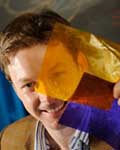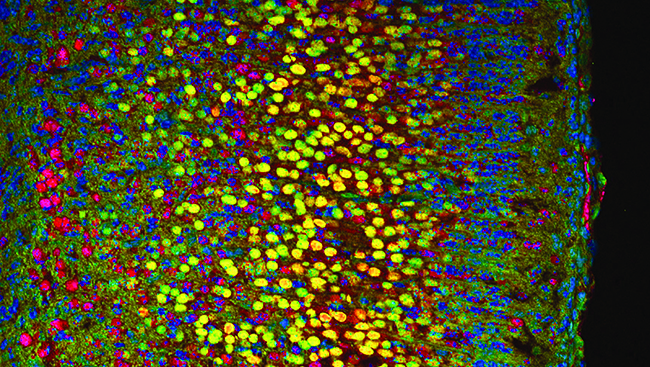
Bevil Conway is a visual neuroscientist and artist who examines the neural basis of color using physiological, behavioral, and modeling techniques. He is an associate professor of neuroscience at Wellesley College and runs a lab split between Wellesley College and the Massachusetts Institute of Technology. At Neuroscience 2015, Conway spoke at the Professional Development Workshop, “Teaching Neuroscience to Nonscientists.” In this interview, he delves into why he focuses on empowering the student as the expert and leader of their own learning.
How do you approach teaching neuroscience to undergraduates in a liberal arts setting?
Our job as educators is to not only give students skills they might need to find a job, but also to engender creative thinking, problem solving, an ability to handle large data sets, and an ability to think quantitatively.
My strategy has been to develop courses that put the students first, build on their interests, and motivate their quantitative thinking skills. I also strive to foster a diverse classroom because diversity brings a range of perspectives that can be useful to problem solving.
How do you implement this strategy in your labs?
Ultimately, I want to get students to start practicing being the expert. My approach draws on problem-based learning. Students discover the full richness of a problem and then have to figure out how to solve it.
For example, I put together an advanced laboratory-based course on vision and art that consists of lectures and reading assignments, and also hands-on laboratory work, much of which takes place in the studio where students are making art and thinking about what it tells them about the process of vision, perception, and cognition.
My labs tend to have very succinct instructions, because I want the students to be the experts, and to start discovering for themselves what the problem is. An example is a very simple cow eye dissection. I say, “You will dissect a cow eye and should measure the focal length of the cow eye lens.” And that’s the whole lab! They have to wrestle with, “Well, what is a focal length?”
The students taking the course have to pool their resources to figure out the different pieces to this problem. So they put it all together and conclude that the focal length of the cow eye lens doesn’t make any physiological sense. It’s at this point when the best students of the group carry everyone forward into wrestling with have they done the calculation wrong or did they do the dissection wrong. Through this process, they not only discover how the eye works and how optics work, but they also discover the practice of doing science. They start to think critically about what science is and then can apply this problem-based approach to the next set of labs. (The measurements are accurate, but not physiologically relevant: the refractive power of the lens changes when it is removed from the eye, and its optical properties are measured in air instead of salty water.)
The final piece is an independent term project where the students are given a project with very simple instructions: Pick a question you’re interested in, design an experiment that involves measuring something, and present your results. Because science is a social enterprise, I want them to discover how to turn what I call their “dorm room ideas,” such as “Do you see red like I see red?” into something empirical and testable.
They can see with hands-on experience how science operates through a trial and error process where sometimes you have to challenge your ideas and redesign an experiment again and again.
How do you guide the students through these assignments?
Most of the time, the students are very good at figuring out if they are having difficulty in tackling their assignments. They have less conviction in identifying what their problem might be. They feel like there’s some issue, but they think they don’t have enough expertise to identify the problem. I’ve found that if I point out the problem, very often they’ll say, “I thought that was the case.” So my MO has been to say, “Do you think there are any problems?” Then I listen, encourage them to brainstorm, help them walk through developing an experimental design that they can fully visualize.
The other important piece is learning when to quit. I encourage the students to think creatively in the course of their experiment for alternative ways to tackle their problem. That aspect of science is often underappreciated and overlooked.
How do you assess the curriculum?
Through questionnaires and after-the-fact interviews. That gives us a rich perspective on what the students think. We try to deploy some quantitative metrics in the form of student evaluation questionnaires administered immediately after the course is over, but before the students receive their grades. But these evaluations must be treated with caution: It might not be appropriate to use the student as the primary metric for success. We have to try to meet their expectations, but we shouldn’t use them as the sole measure of whether or not the curriculum is successful.
We track students using social media, and many of them will report years later that this course provided them with the best training for their current job and that they were not aware of the benefits at the time they took the course. The students are not all in graduate school or medical school; it’s people doing health policy, law, working in politics, and so on.
We also do very extensive peer review. We bring in outside evaluators to look at the curriculum and how our courses are being conducted, and these peer teachers visit the classroom while we’re teaching.
How is the curriculum changing as a result of that feedback?
There are some students who really do not do well in this open-ended format because they want to know exactly what they should know. Disabusing them of that conception has required some revision of the curriculum.
I’ve provided more background resources. In some of the labs, for example, I’ll have lists of websites. And I give students examples of term projects from prior semesters. I also develop hand-outs with a few key experimental figures addressing a question we might have raised in discussion, and then I work with the students on how to interpret original data. How do the data support the hypothesis? How could the data be true, but the hypothesis be false? Learn to distinguish fact versus hypothesis!
We’ve also included a biography assignment where students will talk to a scientist, usually a grad-student or postdoc, or a technician transitioning into graduate school. The idea is to get students to go out and see how science is actually done, and talk to people who are at inflection points in their careers.
The most significant change has been to pull back on the amount of material that I try to cover. The first year that I taught the Vision and Art course, I had about twice as much material as I do now. I came into this endeavor thinking, “If they’re going to learn about vision, they need to know X, Y, and Z.” I’ve come to appreciate that it really isn’t about the total amount of content that makes a course successful, but getting students to be creative, independent, self-motivated thinkers with good quantitative reasoning skills. Guidance from my senior colleagues has been enormously helpful in editing the course.
The last thing is the students genuinely benefit from having exposure to a few expert lectures, so we bring in some outside speakers who are vetted. Also, I now give lectures in which I present an argument and show them how I develop an argument using empirical data. I don’t do that right at the beginning, because I don’t want to perpetuate this idea, “Here’s the stuff you’ll need to know.” It’s more like, “Here are the problems you’re going to confront, go to town.” Around the middle of the semester, I say, “I want you to put your notes away and just listen.” It shifts the focus to the logical structure of forming an argument, how you distinguish between a fact and a hypothesis, an idea versus dogma, and the role of empirical evidence.
What goes into a successful collaboration with nonscientific departments? What has your experience been like?
It really is leveraging personal connections and friendships, and the openness of the institution.
When I put this course forward as an idea, I wrote to the department chair of fine arts at Wellesley, who I had never met, but who I knew because she and I had worked in the same print shop. She wrote back and said, “I’m thrilled! Let’s see if we can make this work.” She put out a call to her faculty and said, “Our studio space is greatly taxed in serving our own classes, but we’d really like to make this work. Can we get some studio space for Bevil for his course?” Two or three faculty got in touch with me and said, “The studio that I’m teaching in is not going to be used on whatever time, so you’re welcome to use it then.” The people of the Davis Museum have also been extraordinarily generous in making the resources of the museum available to us.
I’ve also done a lot of work with Caroline Jones at MIT in the art history department. She and I co-taught a version of the course, Vision and Art, to model for the students this professional, collaborative interaction across disciplines. She would give art history lectures, and I would give neuroscience lectures. The experience made clear the struggle to have the humanities inform the sciences, and have the sciences inform the humanities in a way that isn’t superficial.
Getting a common playing field where people in the different fields are genuinely listening, acknowledging the question and domain within each other’s territory, and coming up with a common vocabulary is the essential starting point. I now try to do that in my own research.
When pursuing this type of cross disciplinary work, I’ve discovered it is absolutely essential to have rigor within your own discipline. I’m a neuroscientist — a neurobiologist — and my scientific work should be of the highest possible caliber. Otherwise, you don’t have the kind of credibility to go into the very open territory of inter-disciplinary or cross-disciplinary work.
Speaker






